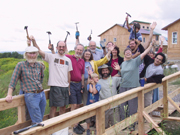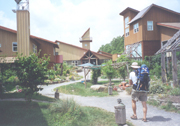Building Utopia
Ithaca’s EcoVillage inspires a Chesapeake Country dream
by Carrie Steele
Neighbors season their family-style, shared meals with conversation about work and life. Kids run through meadows where fruit trees bear fresh foods. After dinner, grassy walkways lure neighbors to spend time outdoors together in acres of preserved natural and restored spaces.
Pity that this utopia is some 400 miles north, in Ithaca, New York.
That environmentally sustainable dream is a New England reality some citizens of Chesapeake Country seek to bring home.
To one Southern Anne Arundel County man, Richard Crenshaw, Ithaca’s 60-home EcoVillage is the stuff dreams are made of. An experiment in village living, EcoVillage balances ecological savvy with a strong social network. There’s nothing like that in these parts.
So the second weekend in April, Crenshaw invited the founder of this EcoVillage to bring the inspiration of sustainable living to the Chesapeake.
Blueprinting a Green Life
The people living at EcoVillage at Ithaca owe their village to Liz Walker and Jared Jones, who created the 175-acre EcoVillage, made up of two neighborhoods of single-family homes with an 11-acre organic farm nearby.
Walker, in turn, credits friend Joan Bokaer.
“We had organized a walk across the U.S. in 1990 that lasted nine months and we had 150 people,” said Walker, who’s a grassroots organizer by trade rather than a community planner. While they walked, they talked about a book Bokaer had read, Co-Housing: A Contemporary Way of Housing Ourselves by Kathryn McCamant and Charles Durrett.
So on that long, long walk across the country, the two friends talked out the idea for EcoVillage. It germinated with other walkers, who later bought houses in the EcoVillage.
Before their green utopia could blossom, they had to raise $400,000 to buy the land.
“We started out with a vision but no money. For me as a single parent, and Joan was also, that was not so easy,” Walker said. Negotiating through New York’s legal structure to buy the land, then starting a 501c(3) “was a huge amount of work, and we had no experience with development and building homes.”
But building a tight community where people know each other’s names was the light at the end of the tunnel for Walker and Bokaer. They walked step by step toward that vision.
Living the Green Dream
Now some 150 kids and adults call EcoVillage home. Each family lives in houses constructed with green materials. Building designs are green, too, keeping their affordable homes well-insulated against the chilly Great Lakes winds.
Neighbors in this village don’t demand huge lawns for themselves, but instead live in private homes tightly clustered along a wide central sidewalk with fruit trees and landscaping. Dense clusters of homes take up less room than conventional neighborhoods because yards are common greens.
Instead of greeting each other along a central main street, people exchange hellos with neighbors in a garden.
People’s cars take a backseat to walking. When villagers drive home from work, they park behind the houses, as everything in their community is within walking distance.
“It’s like living in a park. It’s really beautiful,” Walker says. The first neighborhood was completed nine years ago; the second is just two years old.
Young and old in this community don’t have to travel to find nature. They live next to a 55-acre natural area, with marshes and a constructed lake to cool off in on hot New York summer days.
Neighbors build relationships and share daily tasks in the common house, where cooking meals together in an open kitchen/dining area is a nightly affair. Neighbors also share laundries, play areas for kids and office spaces in their common clubhouse.
“Group meals are not mandatory, but it’s a nice amenity — you get these home-cooked meals several times a week,” Walker says. Neighbors organize the shared meals, with different crews helping out with cooking, serving and cleaning.
Neighbors also get fresh, organic produce during the growing season from their community-supported farm.
“The whole concept is a balance between privacy and community. Co-housing recognizes that people need their own space,” Walker says. “But if you want to go for a walk or see a movie, there’s always someone around.”
Varieties of the Green Dream
Ithaca’s EcoVillage is a living situation categorized as co-housing, explained Walker. But they’re still pioneers.
“We choose to be very mainstream,” she says. “We’re also helping influence developers and builders and show there is a different way of creating development to preserve land around us.”
Walker and village neighbors find company in an even wider community across the country — and world.
They are one of some half-dozen such villages in the United States. Others are in North Carolina, Tennessee, Los Angeles and Missouri.
“Each has its own unique flavor and way of demonstrating a more sustainable way of living,” Walker says. “We demonstrate both environmental and social sustainability.”
In turn, those villages are among some 79 completed co-housing communities in the U.S., most considerably smaller, with 20 to 30 households, Walker estimates.
Yet EcoVillage at Ithaca planners dream even more sustainable dreams: In the future they hope to have village-scale wind power, organic orchards, on-site biological wastewater treatment, graywater recycling, onsite biodiesel/vegetable-oil fuel production and a non-toxic village cemetery.
Sharing the Green Dream
Ithaca’s greenest neighborhood has Shady Side’s Crenshaw in awe. He’s already got a corn-fed stove, a house he designed to heat with passive solar energy and a river-watching e-mail newsletter to document life on the river.
Now, he yearns for a community that operates as a sustainable village. Some members of his community already get their farm produce from community-sustained Ivy Neck Farm in Harwood.
“I’ve fiddled with the idea and put together an EcoVillage that would let people live where they live,” Crenshaw said. His Shady Side version of an EcoVillage would have neighbors exchanging vegetables, cooking dinners together and hosting other activities to knit the community together.
That’s similar to advice Walker says she’ll give to Crenshaw and his neighbors.
“You don’t have to live in an EcoVillage to have a sense of community. You can get that by sharing things: Get together for suppers, play groups for kids, neighborhood projects. There are many ways of creating that sense of belonging,” Walker says.
Belonging is what many of us feel we’ve lost, and crave.
“Our culture has started moving faster,” says Walker, “and people move away from where they grew up, so re-establishing those kind of strong bonds is important.”
Such a tightly woven community is within reach. Crenshaw’s dream needs neighbors like you to come true.
Learn more about this sustainable lifestyle at a slideshow presentation and talk by Liz Walker and Jared Jones on Saturday, April 8 at 7pm at Christ Church, 220 Owensville Rd., West River. Find out more by emailing Crenshaw at [email protected]. Read about EcoVillage at www.ecovillage.ithaca.ny.us.

